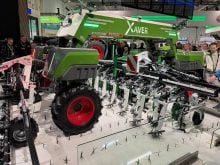LETHBRIDGE – A made-in-Alberta pig identification and animal movement program is coming.
Alberta Pork, a producer organization, has received $200,000 from the government to develop an identification and traceability program as part of the provincial livestock and meat strategy.
The federal government has long demanded a national ID program but Alberta upped the stakes by tying compliance with federal and provincial rules and future farm programs.
“The federal and provincial governments have agreed there will be identification and traceability for livestock,” said general manager Paul Hodgman at a producer meeting in Lethbridge Nov. 12.
Read Also

VIDEO: Agritechnica Day 4: Robots and more robots, Nexat loves Canada and the trouble with tariffs
Agritechnica Day 4: Robots and more robots, Nexat loves Canada and the trouble with tariffs.
“This is the reality of the world and we will just have to get on the boat,” said Murray Roeske of Alberta Pork.
It is more work for producers but it is inevitable, said vice-chair Ben Woolley of Sunterra Farms, which produces 270,000 pigs per year but “the idea of producing this for every bloody pig doesn’t appeal to me.”
Commercial pigs will have a number tattoo and breeding stock will have an ear tag. A group of pigs being moved from farm to farm could be identified with a lot number.
In addition, Alberta Pork plans to introduce a paper manifest to record all pig movement whether hogs are moved from farm to farm or to slaughter.
Alberta Pork and its producer members will own the information that is only released in the event of a serious animal disease so veterinarians can track and stop the infection. Information could also be released during a natural disaster if evacuations become necessary.
A pilot project is underway to develop the form and several versions of the manifest have been written to devise the cheapest and simplest way to follow the pigs.
Copies would be held by the farm, truckers, assembly yards and processors.
In discussions with other countries that already use food traceability, the pork group was told records could be kept electronically, but having paper copies of all activities was equally valuable. This information is also useful in marketing to domestic and export customers who want to know the source of the pork.
All Alberta hog producers are also required to register their premises by year end to qualify for the second instalment of money from the Alberta farm recovery plan. The premises is where the main animal operation is located.
Regulations requiring premises identification will become law after Jan. 1 as part of a new animal health act.















